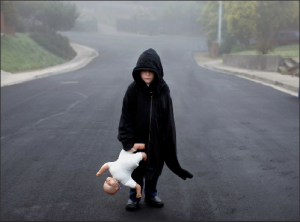Here at Dadwagon, we know all about exploiting our children for artistic and commercial gain. It’s how we became millionaires, of course—by accusing other parents of exploitation and then doing the same ourselves.
But every once in a while, I’m confronted by something where I can’t quite figure out how I feel. Case in point, the work of Timothy Archibald, a photographer whose portraits of his autistic son, Eli, were featured in the New York Times’s “Lens” blog last week. The pictures are, at the very least, haunting: Eli naked, curled up in a plastic container; Eli putting his face into a funnel; Eli with a pair of needlenose pliers in his mouth.
At first, I was ready to condemn this project (now available in book form as “Echolilia”) as pure, beautiful exploitation. The kind of thing I’d probably do, that is. But then, you know, I read the accompanying story, which is where things got murkier. Rather than being Mr. Archibald’s sole idea, many of the compositions were collaborations between father and son:
Sometimes Eli would have an idea for a more interesting pose or setting. Mostly that was Mr. Archibald’s job. He might suggest that they try the shot again at a different time of day or in a place with different light. The collaboration “satisfied something deep inside both of us,” Mr. Archibald said. “We shared — I don’t know what — mutual respect?’’
It makes sense to me. With certain avenues of communication closed off by autism, you take advantage of what remains open, even if outsiders (like a few of the NYT commenters) don’t quite understand. Still, there’s something unsettling about it—possibly because the photos themselves depict a world straddling the line between suburban familiarity and alien isolation. So, I haven’t made up my mind yet.
And that’s partially because, by some strange confluence of circumstances, last week I wound up reading multiple articles about autism. There was another piece in the Times, about how early diagnosis of autism can help mitigate the worst of its symptoms (is that the right word?). That was fine, but straightforward.
My favorite story, though, was the tale (in the Atlantic) of Donald Gray Triplett, a 77-year-old Mississippi man who was the first person ever diagnosed with autism. His life has been kind of amazing. From a childhood spent partly in institutions and partly in the loving care of his family and his community, he’s grown into a fairly independent adult—really, an independent senior citizen—who spends his days not just golfing but traveling the world:
He has been to Germany, Tunisia, Hungary, Dubai, Spain, Portugal, France, Bulgaria, and Colombia—some 36 foreign countries and 28 U.S. states in all, including Egypt three times, Istanbul five times, and Hawaii 17. He’s notched one African safari, several cruises, and innumerable PGA tournaments.
It’s not wanderlust exactly. Most times, he sets six days as his maximum time away, and maintains no contact afterward with people he meets along the way. He makes it a mission to get his own snapshots of places he’s already seen in pictures, and assembles them into albums when he gets home. Then he gets to work planning his next foray, calling the airlines himself for domestic travel, and relying on a travel agent in Jackson when he’s going overseas. He is, in all likelihood, the best-traveled man in Forest, Mississippi.
For certain obvious reasons, his story appeals to me. I’m always fascinated by what drives people to walk out their front doors and embark on ambitious expeditions. Beyond that one line—”It’s not wanderlust, exactly”—the story doesn’t really get into why Mr. Triplett travels. I imagine that it wasn’t an easy question for the writers to ask, or for Mr. Triplett to answer. But it should remind us all of two things: 1. that the “veil of autism,” as it’s often described, can hide a rich and evolving interior life; and 2. that we never really know how our children, autistic or not, will turn out.
Finally, if you’ve got 15 minutes to waste, there’s an Austistic Spectrum Quotient Test floating around on Facebook. It’s worth checking out just to know what the questions are, although I think there’s some debate about how accurate it is. For what it’s worth, I scored a 10.

